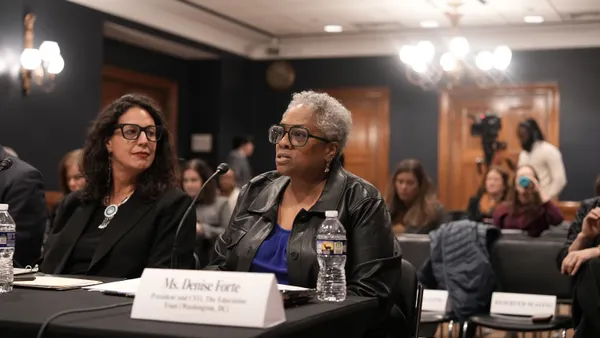Leslie Villegas is a senior policy analyst with the Education Policy program at New America, where she focuses on the pre-K-12 policy landscape for English learners. Her work targets incorporating an equity- and asset-based approach into federal and state education policy through accountability, assessment, funding and other key policy areas.
How states and districts should spend their share of the $190 billion in COVID-19 funds targeted for K-12 education has dominated the education world at every level since the first distribution was announced in March 2020.
Nearly two years later, various spending trackers have been created — including the U.S. Department of Education’s Education Stabilization Fund tracker, the Children’s Funding Project tracker, and the National Conference of State Legislatures’ state-by-state tracker. But many of these trackers have a blind spot for how these funds are being used at the local level.
More notably, there’s little to no tracking of how these funds are trickling down to specific groups of students, including English learners.
English learners make up 10% of K-12 enrollment in the U.S., and these students are more linguistically diverse than most people realize, with the top five languages spoken after English being Spanish, Arabic, Chinese, Vietnamese and Somali. English learners live and learn in every state and have been disproportionately affected by the pandemic. Yet up until now, there has been a severe lack of information on how federal recovery funds are being used to address these students’ particular needs.
Recently, the Collaborative for Student Success, the Center on Reinventing Public Education, and the Edunomics Lab at Georgetown University launched the EduRecoveryHub to identify innovative education practices that states and localities have adopted to help students recover from the interrupted learning caused by the pandemic. The promising practices highlighted by the hub were analyzed by a panel of education policy and practice experts.
As an education policy expert who has written about how to maximize this funding for English learners and examined how states are approaching English learners’ most pressing needs, I was tasked with weighing in on whether these practices would benefit communities that are often overlooked. Needless to say, I approached the review process with equal parts hope and skepticism.
While none of the "promising practices" applied specifically to English learners, there were numerous practices that could benefit them. For example, Colorado’s $9 million investment to provide free mental health sessions or Connecticut’s $2 million student well-being self-assessment system can undoubtedly help address the needs of English learners whose parents are particularly concerned about their mental and emotional health.
Unfortunately, many practices seemed to overlook the specific needs of English learners altogether. A plan to hire more family engagement specialists, for example, should be coupled with intentional recruitment of bilingual liaisons who share the language(s) spoken by English learners. Otherwise, those families will continue to have issues engaging in their children’s education.
What is more, policies aimed at “accelerating learning” were often unclear about how English learners’ unique linguistic and academic needs and assets would be accounted for. For example, plans to develop statewide model curricula lacked details about whether English learners will be provided integrated language support throughout the entire curriculum.
In fact, English learners are often an afterthought in curriculum design, which means supports for these students are often add-ons that are not necessarily embedded with the content. Likewise, trying to make up for missed instructional time by adding days to the school calendar or creating opportunities for targeted support — such as before- or after-school care and during the summer — will require additional steps to ensure English learners will benefit.
State and local education agencies are under tremendous pressure to spend the funds now. But to be intentional and effective, we need to stop looking for silver bullets and start thinking about what investments are needed to have the best possible long-term impact on all students. When it comes to English learners and other linguistically diverse students, we know what works: access to instructional programs and materials that tap into their linguistic and cultural assets.
For English learners, promising practices include things like:
- Providing intensive training for general education teachers on how to support English learners in their classrooms.
- Investing in materials and curriculum in students’ home language(s).
- Creating or expanding dual language programs specifically geared toward English learners.
- Hiring temporary counselors (bilingual if possible) to help address mental health issues.
All of these can be allowable expenditures under federal recovery fund requirements.
State and local education agencies are required to “meaningfully engage” with stakeholders and take public input into account. But there has been a significant disconnect between those deciding how to spend the money and those most in sync with the needs of students. Federal recovery funding plans are not set in stone, which means states and districts can pivot their approach if they find their students would benefit from alternative investments after consulting with the appropriate educators.
Right now, funds are sitting with school districts, and it is time for local English language educators, administrators and specialists to be proactively engaged to ensure they are able to voice the needs of their English learner students. Local education leaders should also think creatively about how to maximize the whole pot of money available to support English learners.
While COVID-19 relief funding may be temporary, these other funding streams are not, which means using emergency funding wisely today may help make the case for increased funding in the future.






 Dive Awards
Dive Awards










